World Water Day
This year’s theme on World Water Day is ‘Water for Peace’ and highlights the critical role played by water in the stability and prosperity of the world.
In the television series 'Leila' (2019), directed by Deepa Mehta, viewers are transported to a dystopian future characterized by rampant water shortage and stark socioeconomic segregation, with the rich and poor being divided by literal tall walls. While the premise may seem exaggerated, recent news articles shedding light on water crises in cities like Bangalore and Chennai serve as stark reminders of the urgent need for action.
Water, an intrinsic component of our daily existence, not only sustains life but also serves as a silent catalyst for peace, a connection frequently overlooked. Discussions on water security often emphasize on the use of shared resources between nations and states, yet urban inequality exacerbates the effects of water insecurity even within cities. ‘Water for Peace’ in its truest essence can only be achieved when the most marginalised sections of society are able to access drinking quality water without interruptions.
At times, it can be challenging to grasp the power that water holds. Yet, the profound impact that water can make to one’s life is unparalleled. Clean water has the transformative ability to enhance the daily existence of individuals, eradicating diseases, empowering women to pursue economic opportunities, and facilitating children's access to education. Increasingly, water dynamics are becoming central to matters of peace and conflict resolution, reflecting the growing scarcity and competition for this vital resource. Therefore, the necessity of establishing an inclusive and sustainable water supply for cities has become abundantly clear.
Amidst this context, the state of Odisha in India stands out as a notable example. The state has attempted to supply 24x7 water to urban households in Puri—including 66,000 slum dwellers, under its flagship Drink from Tap (DFT)
Scheme launched in 2020. This feat is achieved through a systems approach using technological solutions such as IoT embedded smart water management systems. However, what sets DFT apart are not the pipes, meters and taps that go into the machinery, rather the hands of the operators and women-only SHG members (Jal Saathis) that weave together a unique techno-social initiative.
The value of such a scheme is more apparent in the daily lives of urban poor. Unlike their more affluent neighbours, who have the luxury of storing water in above-ground or underground tanks and employing advanced filtration methods, these communities rely solely on the water provided by the government. In addressing the diverse needs of all segments of society, the mission endeavors not just to avert conflicts arising from water scarcity and mismanagement but also to transcend conflict, fostering the holistic well-being of citizens. Under DFT, Puri became India’s first city to offer round-the-clock, quality tap water to all its residents—even catering to the floating population of the city through the service of public taps.
A key factor that contributes to the success of any mission is its continuous monitoring and evaluation. In 2022, Government of Odisha engaged NIUA to conduct an evaluation of Odisha’s Drink from Tap (DFT) Mission in Puri. Our
research delved into the impact and efficiency of the DFT scheme while also benchmarking it against other similar-sized water utilities in the world. The evaluation encompassed comprehensive consumer perspective surveys in selected zones of Bhubaneswar and all areas of Puri, bringing out notable insights from the grassroots.
Insights from the Consumer Perspective Surveys of DFT
Consumer Satisfaction
In Bhubaneswar, 76% respondents residing in slums were satisfied with the water supplied through DFT. This is a remarkable feat, considering how the system was still in its nascent stages of development. In any mission that caters to all strata of society it is important to also specifically measure the impact in the respective communities.
For a 24x7 water supply system, only the households that have no storage facilities and filtration avenues will be able to gauge the true effectiveness of the scheme.
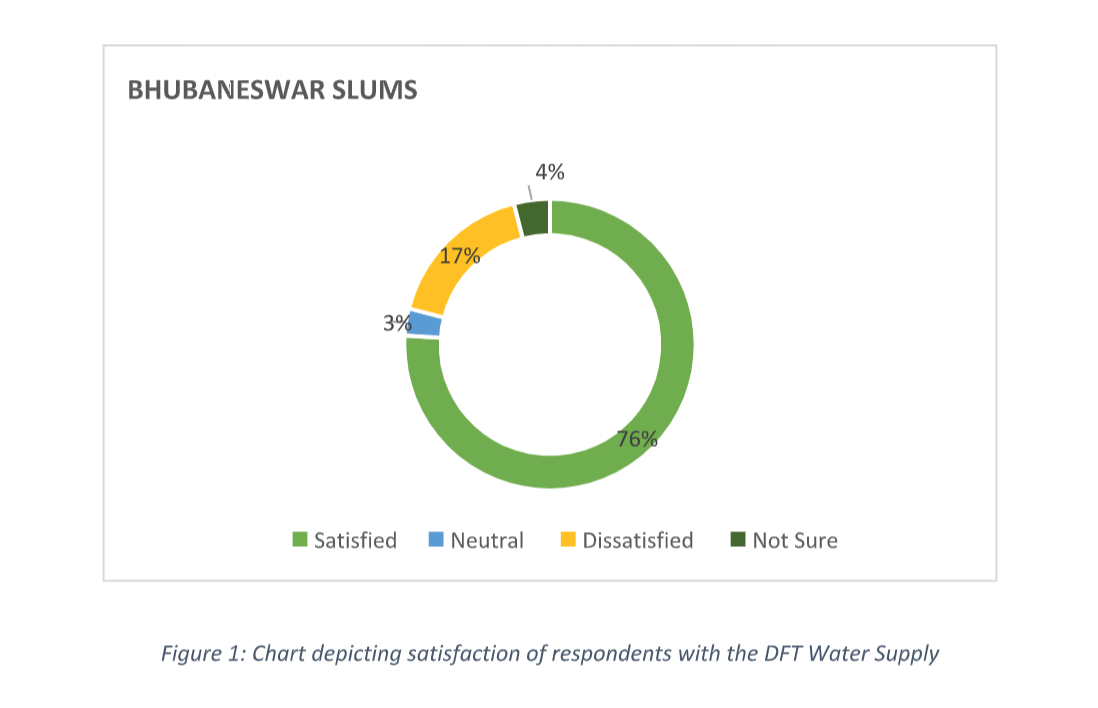
In Bhubaneswar, 88% of respondents living in slums reported uninterrupted water supply, whereas in Puri, 58% of slum residents experienced no disruptions. This achievement is noteworthy, particularly given the challenges faced by urban poor in accessing basic amenities.
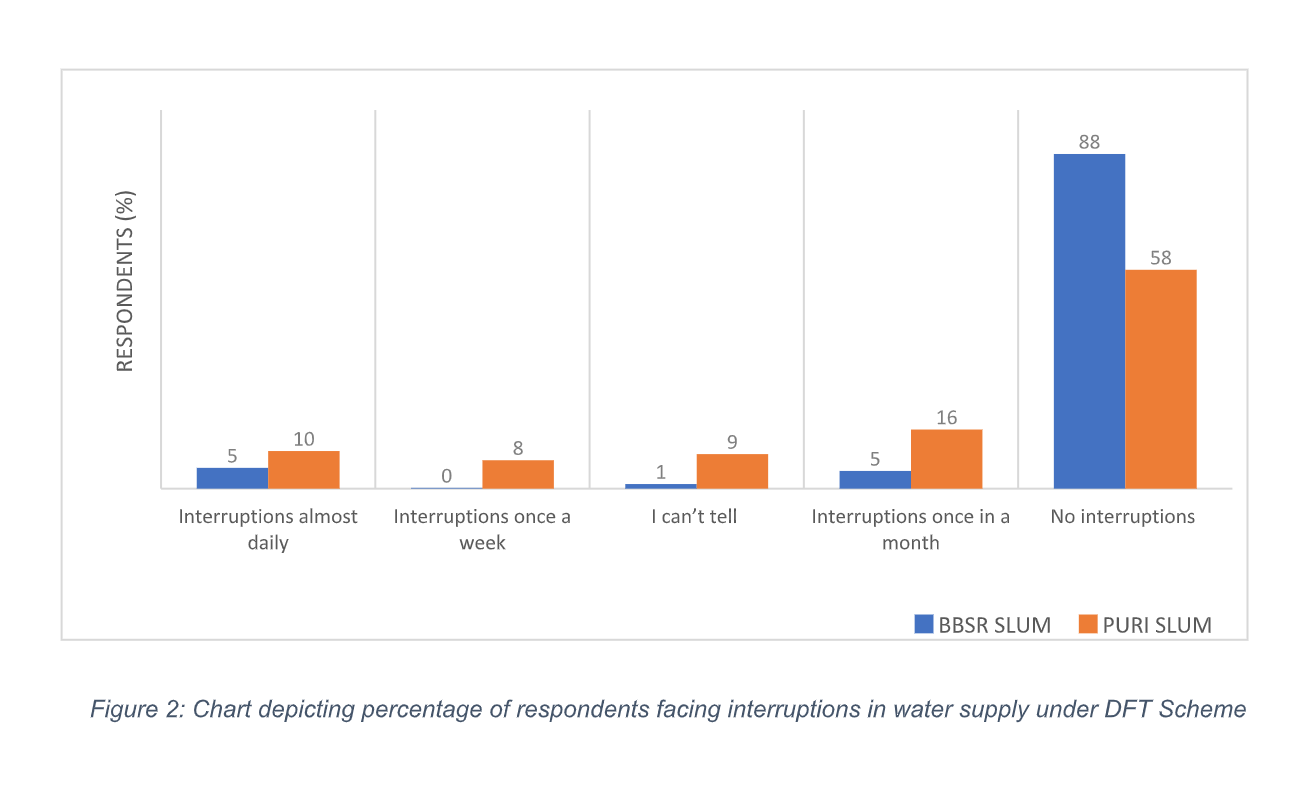
Storage of Water
Similarly, we could also observe that post DFT scheme was implemented, the water storing patterns drastically changed. In Bhubaneswar there was a 70% decrease in the percentage of people who stored water every day, while in Puri there was a decrease of 35%. A pre-requisite for a successful 24x7 water supply is to make storage of water at a household level redundant in the longer run, so as to reduce overall water demand. A positive move towards this feature can be seen in both Bhubaneswar and Puri.
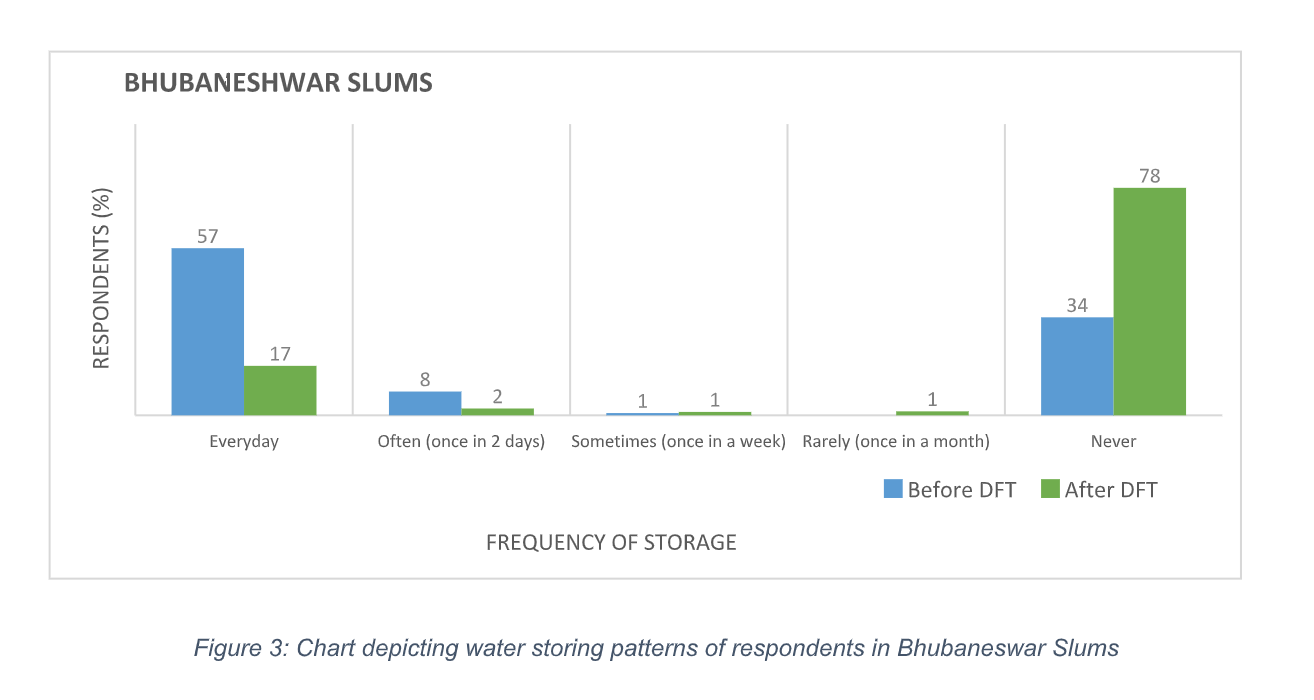
Socio-economic Impact
Unsurprisingly, it was found prior to DFT the responsibility of fetching water for their households predominantly fell on women and girl children (82% in Bhubaneshwar and 86% in Puri). The DFT mission thus specifically caters towards improving gender outcomes by reducing the time it takes to fetch water and directing it towards other productive activities. Notably, 16% of respondents in Bhubaneshwar and 8% in Puri reported reallocating the saved time towards educational activities. This statistic underscores DFT's positive impact on empowering girl children, affording them more time for academic pursuits. Another key finding was that households in Bhubaneshwar experienced an average time savings of around 90 minutes per household, while the savings were approximately 40 minutes per household in Puri.
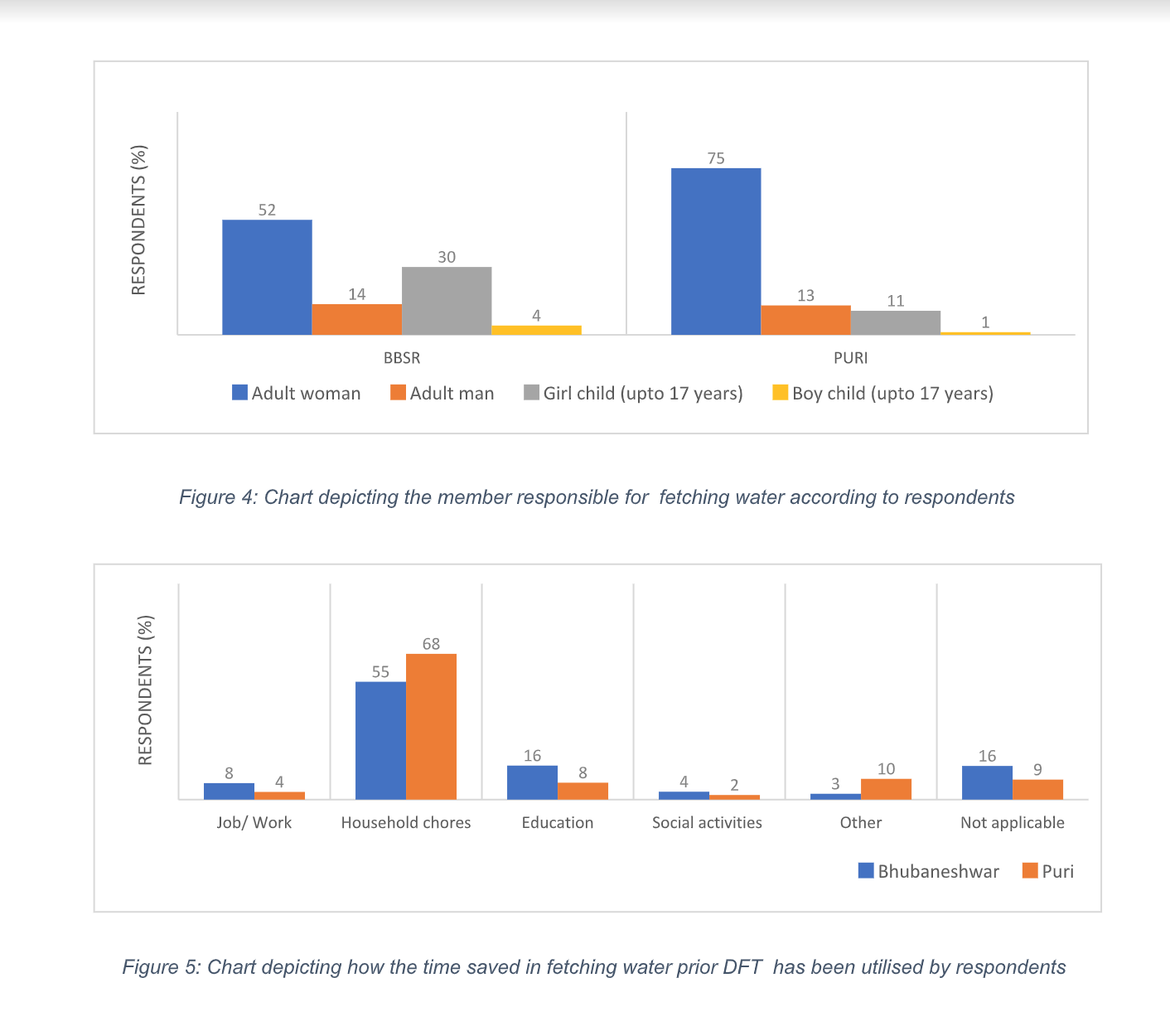
An overwhelming majority of respondents from both slum and non-slum areas in Puri and Bhubaneswar expressed that the 24x7 water supply scheme significantly improved their quality of life by helping them access water conveniently. This underscores water's pivotal role in enhancing equity by enhancing health outcomes and reducing time and financial burdens across all communities.
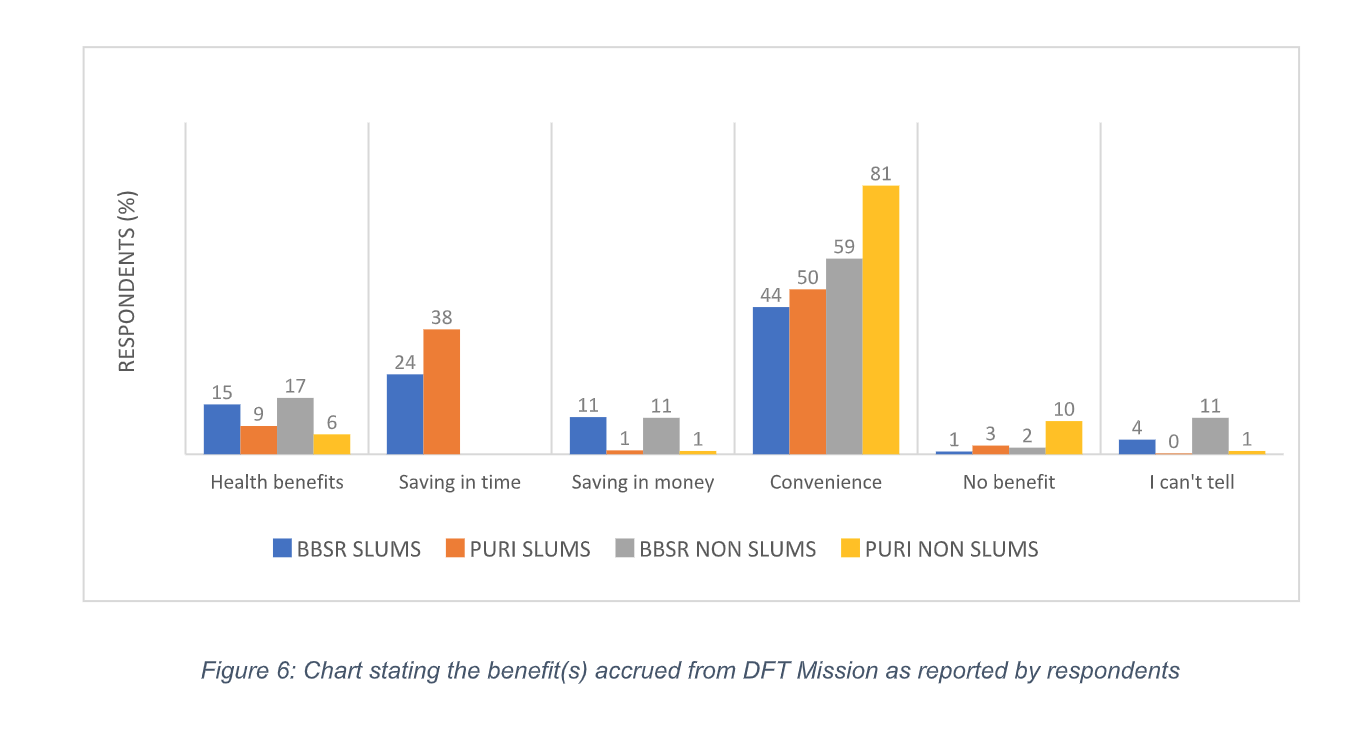
The Government of Odisha’s strides towards urban development represent an aspirational model that many state governments and cities can adopt. The DFT mission is planned to be scaled up to all 115 ULBs, forging a connection between the demand and supply of water—one that is not dictated by market forces alone but also by proactive government action and community engagement. At its core, missions that prioritize the needs of the marginalized exemplify ‘water for peace’ and persevere to build a future for all citizens. By fostering collaboration among communities, as they pool their assets and resources, both citizens and government can reap the benefits of shared prosperity, envisioning a future devoid of tall walls.
Author
